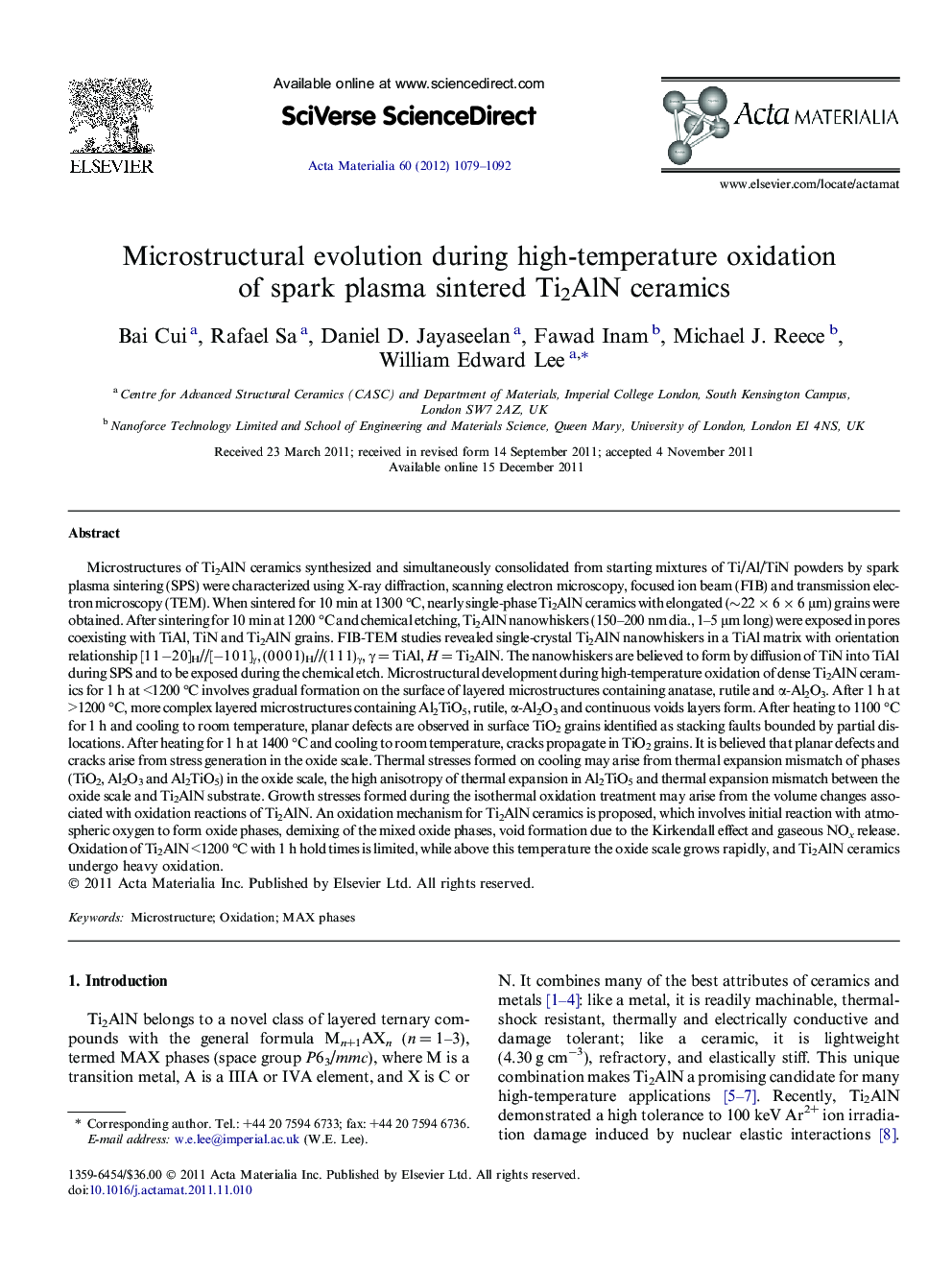| کد مقاله | کد نشریه | سال انتشار | مقاله انگلیسی | نسخه تمام متن |
|---|---|---|---|---|
| 10620520 | 988634 | 2012 | 14 صفحه PDF | دانلود رایگان |
عنوان انگلیسی مقاله ISI
Microstructural evolution during high-temperature oxidation of spark plasma sintered Ti2AlN ceramics
دانلود مقاله + سفارش ترجمه
دانلود مقاله ISI انگلیسی
رایگان برای ایرانیان
موضوعات مرتبط
مهندسی و علوم پایه
مهندسی مواد
سرامیک و کامپوزیت
پیش نمایش صفحه اول مقاله

چکیده انگلیسی
Microstructures of Ti2AlN ceramics synthesized and simultaneously consolidated from starting mixtures of Ti/Al/TiN powders by spark plasma sintering (SPS) were characterized using X-ray diffraction, scanning electron microscopy, focused ion beam (FIB) and transmission electron microscopy (TEM). When sintered for 10 min at 1300 °C, nearly single-phase Ti2AlN ceramics with elongated (â¼22 Ã 6 Ã 6 μm) grains were obtained. After sintering for 10 min at 1200 °C and chemical etching, Ti2AlN nanowhiskers (150-200 nm dia., 1-5 μm long) were exposed in pores coexisting with TiAl, TiN and Ti2AlN grains. FIB-TEM studies revealed single-crystal Ti2AlN nanowhiskers in a TiAl matrix with orientation relationship [1 1 â2 0]H//[â1 0 1]γ, (0 0 0 1)H//(1 1 1)γ, γ = TiAl, H = Ti2AlN. The nanowhiskers are believed to form by diffusion of TiN into TiAl during SPS and to be exposed during the chemical etch. Microstructural development during high-temperature oxidation of dense Ti2AlN ceramics for 1 h at <1200 °C involves gradual formation on the surface of layered microstructures containing anatase, rutile and α-Al2O3. After 1 h at >1200 °C, more complex layered microstructures containing Al2TiO5, rutile, α-Al2O3 and continuous voids layers form. After heating to 1100 °C for 1 h and cooling to room temperature, planar defects are observed in surface TiO2 grains identified as stacking faults bounded by partial dislocations. After heating for 1 h at 1400 °C and cooling to room temperature, cracks propagate in TiO2 grains. It is believed that planar defects and cracks arise from stress generation in the oxide scale. Thermal stresses formed on cooling may arise from thermal expansion mismatch of phases (TiO2, Al2O3 and Al2TiO5) in the oxide scale, the high anisotropy of thermal expansion in Al2TiO5 and thermal expansion mismatch between the oxide scale and Ti2AlN substrate. Growth stresses formed during the isothermal oxidation treatment may arise from the volume changes associated with oxidation reactions of Ti2AlN. An oxidation mechanism for Ti2AlN ceramics is proposed, which involves initial reaction with atmospheric oxygen to form oxide phases, demixing of the mixed oxide phases, void formation due to the Kirkendall effect and gaseous NOx release. Oxidation of Ti2AlN <1200 °C with 1 h hold times is limited, while above this temperature the oxide scale grows rapidly, and Ti2AlN ceramics undergo heavy oxidation.
ناشر
Database: Elsevier - ScienceDirect (ساینس دایرکت)
Journal: Acta Materialia - Volume 60, Issue 3, February 2012, Pages 1079-1092
Journal: Acta Materialia - Volume 60, Issue 3, February 2012, Pages 1079-1092
نویسندگان
Bai Cui, Rafael Sa, Daniel D. Jayaseelan, Fawad Inam, Michael J. Reece, William Edward Lee,